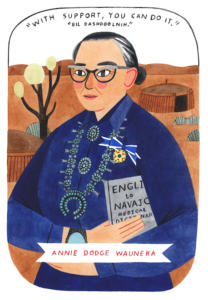UTAH WOMEN’S HISTORY / Explore the History / Utah Tribal Lands / Navajo Nation

Navajo Nation Tribal Lands
Key Players
Annie Dodge Wauneka
Annie Dodge Wauneka was the second woman elected to the Tribal Council of the Navajo Nation. During her three terms in that office, she worked to improve public health on the Nation by combating the spread of tuberculosis. She hosted a radio show, created a Navajo-English medical dictionary, and started many programs that had a direct impact on Navajo families’ lives. Later, she was a member of the advisory board for the U.S. Public Health Service, and in 1963, she was honored with the Presidential Medal of Freedom.
Read our longer bio of Annie Dodge Wauneka here.
Mary Holiday Black
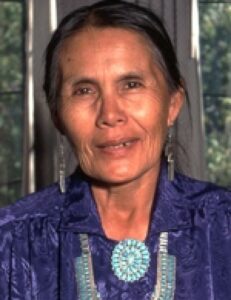
Photo by James V. Gleason.
Mary Holiday Black, born c. 1934 in Utah’s Monument Valley, is a renowned basket weaver credited with reviving traditional Navajo basketweaving. A member of the Bitter Water Clan, she was raised in a traditional community where her mother was a rug weaver and her father a medicine man. Navajo basketweaving went into a severe decline in the 1960s; Mary Holiday Black helped spark a renaissance of basketweaving in the next decade by introducing innovations in basket design, fabrication, and use. These include the creation of “story baskets,” which feature both geometric designs and images with religious significance, such as the yei-be-chei (supernatural beings), who figure prominently in traditional mythology. She became the first Utahn to receive the National Endowment for the Arts’ National Heritage Fellowship in 1995.
Dalene Redhorse
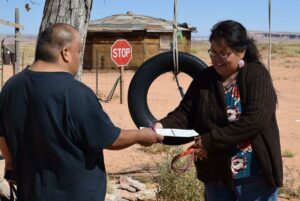
Dalene Redhorse helps Kevin Blackhorse register to vote. Maggie McGuire, Moab Sun News.
Dalene Redhorse has lived in rural San Juan County in Utah for her entire life. She’s a field organizer with the non-profit Rural Utah Project. Together with her team, she has helped provide “plus code” addresses for over 6,000 structures on the Utah portion of the Navajo Nation reservation, which had previously lacked traditional street addresses. The creation of these new addresses is a crucial part of voter registration as well as improved access to Emergency Medical Services, mail delivery, business licenses, social services, and more. Dalene speaks with residents in both English and Navajo as she distributes address plates, working, in her own words, to “make [her] community more visible.”
Ruth Roessel
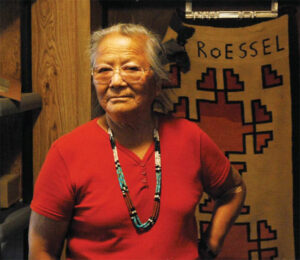
Photo by Peter Swanson.
Ruth Roessel was a Navajo educator and writer who played a key role in founding the Rough Rock Demonstration School in 1965, the first Native-American controlled community school in the country. She also helped found the Navajo Community College (now Diné College) in 1968. Ruth was born in Round Rock, Arizona in 1934 and attended Bureau of Indian Affairs boarding schools as a child, which she did not enjoy because of the long periods of separation from her family. She and her husband, Dr. Robert Roessel Sr., formulated a new kind of dual education system that combined western education and Diné education, including Navajo language, culture, and history. In addition to writing numerous academic papers and articles about Navajo history, culture, and education, she also wrote five books, including Navajo Stories of the Long Walk, Women in Navajo Society, and Navajo Livestock Reduction: A National Disgrace. She died in 2012.
Key Events
1952 - Miss Navajo Nation Pageant
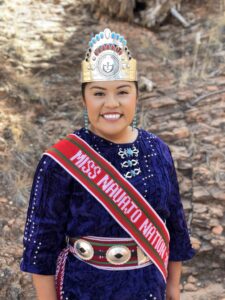
2019-2020 Miss Navajo Nation Shaandiin Parrish. Courtesy Miss Navajo Nation.
The Miss Navajo Nation Pageant began in 1952 and is still held every year at the Navajo Nation Fair. Contestants compete in activities that center on traditional and contemporary Navajo language and culture. These include sheep butchering, making fry bread, carding and spinning wool, and rug weaving. Most importantly, Miss Navajo Nation contestants must be fluent in both Navajo and English. The mission statement of Miss Navajo Nation declares that the winner is “to exemplify the essence and characteristics of First Woman, White Shell Woman and Changing Woman” as well as to be “a leader, teacher, counselor, advisor and friend” to the Navajo people.
Dr. Beulah Melvin Allen was the first Miss Navajo, elected in 1952. Today, Miss Navajo Nation typically spends much of her time visiting the homes of the elderly and strengthening youth programs. In 2004, former Miss Navajo Nation titleholders Sarah Johnson Luther and Sunny Dooley reached out to other former Miss Navajos in order to create Miss Navajo Council, Inc., an organization of former titleholders that are “well versed in the Navajo language, culture, tradition and in the contemporary world [that] would make a unique resource and could be of service to the Navajo Nation.” They regularly organize events such as workshops and lecture series.
Key Places
The Four Sacred Mountains
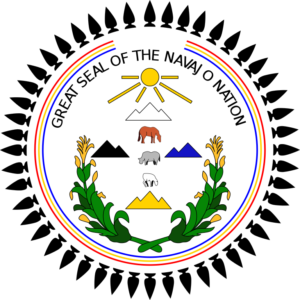
Wikimedia Commons.
The four sacred mountains mark the geographical and spiritual boundaries of Diné Bekeyah, or the traditional homeland of the Navajo people. They are the east mountain Sisnaajini (Mt. Blanca), in south-central Colorado, the south mountain Tsoodzil (Mt. Taylor), in northwestern New Mexico, the west mountain Dook’o’oosliid (San Francisco Peaks), in northwestern Arizona, and the north mountain Dibe Ntsaa (Mt. Hesperus), in southwestern Colorado. Navajo origin stories say that each of these sacred mountains was given specific natural endowments as well as the natural beauty and powers of the universe. The four original Navajo clans, who were the first to inhabit these sacred mountains, were created by Changing Woman, the spiritual mother of all Navajo people. Although the Navajo Reservation today is significantly smaller than the land within the area of the four sacred mountains, it is still the largest American Indian reservation in the country, extending over 25,000 square miles across 9 counties. Navajo people in Utah “also acknowledge the cultural significance of several other mountains, including Naatsisaan (Navajo Mountain), Dzil Diloi (Abajo Peaks), and Shash Jaa (Bear’s Ears).”
The Rough Rock Demonstration School
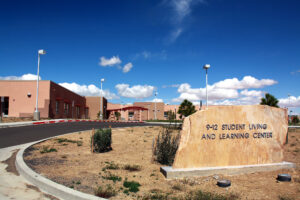
Dyron Murphy Architects.
The Rough Rock Demonstration School, the first Native-American controlled community school in the country, was founded by Ruth Roessel in 1965. In the early and mid-twentieth century, Navajo children generally attended Bureau of Indian Affairs boarding schools, which often entailed long periods of separation from their families and the loss of their ability to speak the Navajo language. The involvement of Navajo parents and the all-Navajo leadership of the RRDS was a significant change. Renamed the Rough Rock Community School in 1994, the school utilizes a dual education system formulated by Ruth Roessel and her husband, Dr. Robert Roessel Sr., that combines western education and Diné education, including Navajo language, culture, and history.


